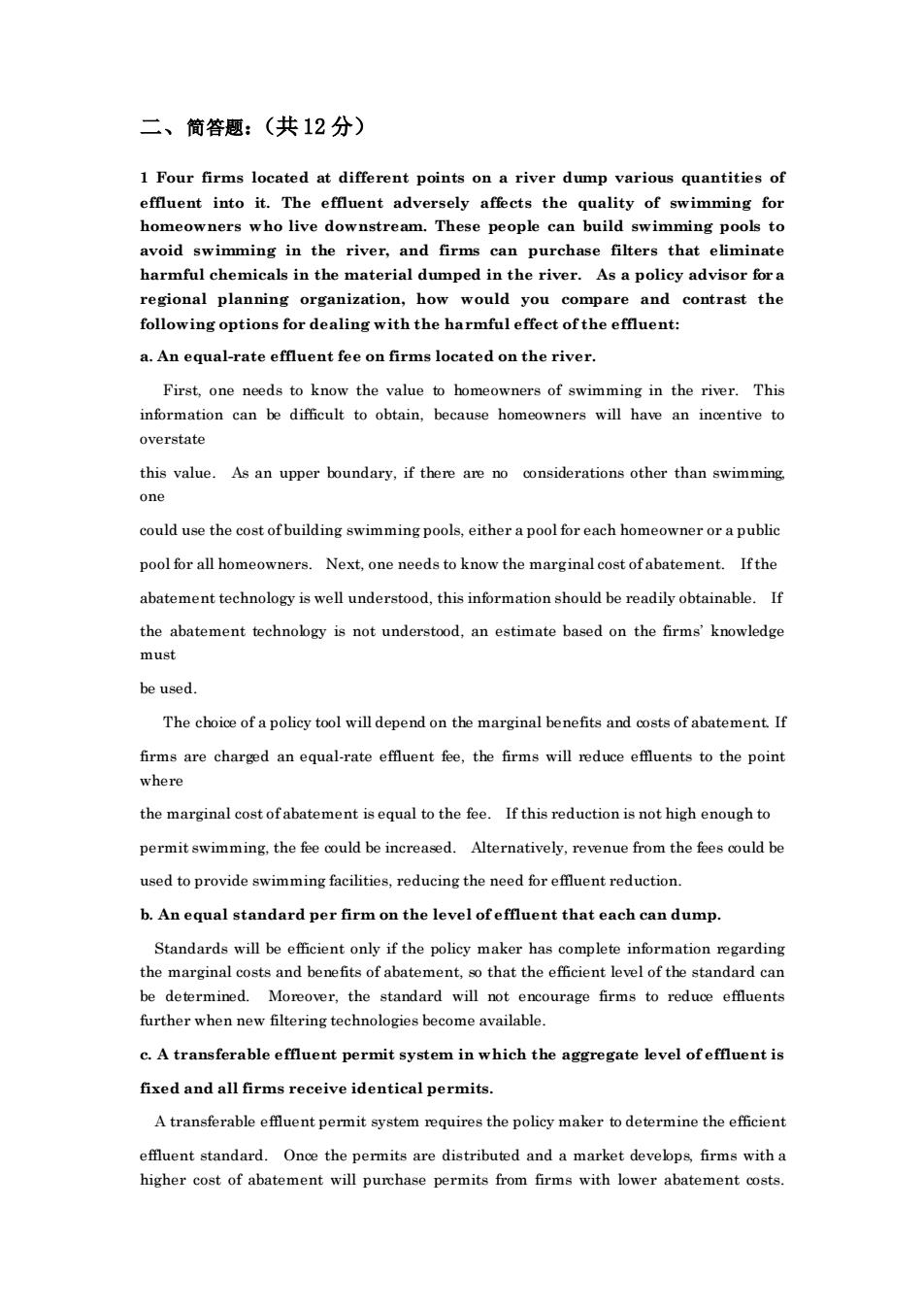正在加载图片...

二、简答题:(共12分) 1 Four firms located at different points on a river dump various quantities of effluent into it.The effluent adversely affects the quality of swimming for homeowners who live downstream.These people can build swimming po ols to avoid swi mming in the river, can purchase filters that eliminate harmful chemicals in the material dumped in the river.As a policy advisor for a regional planning organization,how would you compare and contrast the following options for dealing with the harmful effect of the effluent: a.An equal-rate effluent fee on firms located on the river. First,one needs to know the value to homeowners of swimming in the river.This information can be difficult to obtain,because homeowners will have an incentive to overstate this value.As an upper boundary,if there are no considerations other than swimming one could use the cost of building swimming pools,either a pool for each homeowner ora public pool for all homeowners.Next.one needs to know the marginal cost ofabatement.Ifthe abatement technology is well understood,this information should be readily obtainable.If the abatement technology is not understood,an estimate based on the firms'knowledge must be used. The choice of a policy tool will depend on the marginal benefits and costs of abatement If firms are charged an equal-rate effluent fee,the firms will reduce effluents to the point where the marginal cost ofabatement is equal to the fee.If this reduction is not high enough to permit swimming.the foo could be increased.Alternatively.revenue from the fees could be used to provide swimming facilities,reducing the needor efen reduction. b.An equal standard per firm on the level of effluent that each can dump be efficient only if the policy maker has complete informa the marginal costs and benefi fits of ah ent level of the standard can be determined.Moreover,the standard will not encourage firms to reduce effluents further when new filtering technologies become available. c.A transferable effluent permit system in which the aggregate level of effluent is fixed and all firms receive identical permits. A transferable effluent permit system requires the policy maker to determine the efficient effluent standard.Once the permits are distributed and a market develops firms with a higher cost of abatement will purchase permits from firms with lower abatement costs 二、简答题:(共 12 分) 1 Four firms located at different points on a river dump various quantities of effluent into it. The effluent adversely affects the quality of swimming for homeowners who live downstream. These people can build swimming pools to avoid swimming in the river, and firms can purchase filters that eliminate harmful chemicals in the material dumped in the river. As a policy advisor for a regional planning organization, how would you compare and contrast the following options for dealing with the harmful effect of the effluent: a. An equal-rate effluent fee on firms located on the river. First, one needs to know the value to homeowners of swimming in the river. This information can be difficult to obtain, because homeowners will have an incentive to overstate this value. As an upper boundary, if there are no considerations other than swimming, one could use the cost of building swimming pools, either a pool for each homeowner or a public pool for all homeowners. Next, one needs to know the marginal cost of abatement. If the abatement technology is well understood, this information should be readily obtainable. If the abatement technology is not understood, an estimate based on the firms’ knowledge must be used. The choice of a policy tool will depend on the marginal benefits and costs of abatement. If firms are charged an equal-rate effluent fee, the firms will reduce effluents to the point where the marginal cost of abatement is equal to the fee. If this reduction is not high enough to permit swimming, the fee could be increased. Alternatively, revenue from the fees could be used to provide swimming facilities, reducing the need for effluent reduction. b. An equal standard per firm on the level of effluent that each can dump. Standards will be efficient only if the policy maker has complete information regarding the marginal costs and benefits of abatement, so that the efficient level of the standard can be determined. Moreover, the standard will not encourage firms to reduce effluents further when new filtering technologies become available. c. A transferable effluent permit system in which the aggregate level of effluent is fixed and all firms receive identical permits. A transferable effluent permit system requires the policy maker to determine the efficient effluent standard. Once the permits are distributed and a market develops, firms with a higher cost of abatement will purchase permits from firms with lower abatement costs